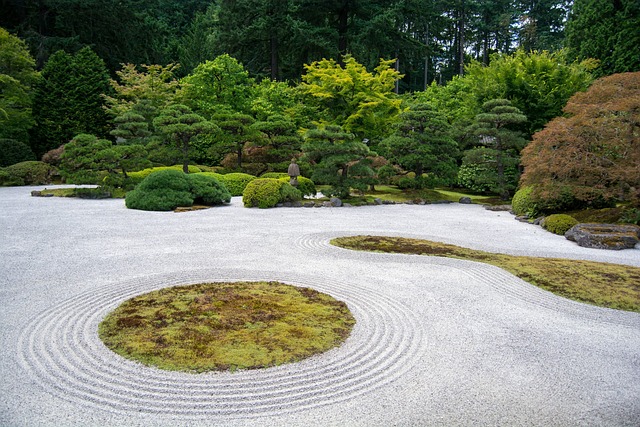Incorporating permaculture principles into your backyard promotes a vibrant and sustainable ecosystem. Start by understanding your site's unique characteristics for optimal plant selection and efficient water use. Adopt native plant landscaping, drought-tolerant species, and composting to create a self-sustaining, eco-friendly oasis that supports local wildlife and minimizes waste. These practices blend ecological balance with beautiful design, offering both environmental benefits and a peaceful retreat.
Transform your backyard into a thriving eco-friendly oasis with permaculture-inspired designs. This approach to landscaping offers a sustainable and aesthetically pleasing space that benefits both you and the environment. In this article, we explore the core principles of permaculture for your backyard, from understanding its design philosophy to harnessing the power of native plants and efficient water use. Discover green backyard ideas that blend beauty with functionality, ensuring a vibrant, resilient, and sustainable outdoor sanctuary.
The Principles of Permaculture for Your Backyard
Incorporating permaculture principles into your backyard is a powerful way to create a vibrant, sustainable space that supports both nature and your needs. This holistic design approach emphasizes ecological balance, efficiency, and resilience—all achievable through simple yet effective practices. Start by considering your site’s unique characteristics, such as soil type, climate, and available sunlight. Design with these in mind to ensure plant choices are well-suited and water use is optimized.
Native plant landscaping is a key permaculture strategy for a green backyard. These plants provide food and habitat for local wildlife while reducing the need for synthetic fertilizers and pesticides. Drought-tolerant species not only conserve water but also thrive during dry spells, making them ideal for a water-efficient backyard. Composting, another essential permaculture practice, transforms organic waste into nutrient-rich soil amendments, fostering a closed-loop system that minimizes waste and enriches your garden.
– Understanding permaculture design
Permaculture design is a holistic approach to creating harmonious and sustainable spaces, focusing on mimicking natural ecosystems. In the context of backyard transformations, this means designing areas that are both beautiful and beneficial for the environment. By integrating principles like native plant landscaping, drought-tolerant choices, and water-efficient practices, you’re not just enhancing your outdoor space but also contributing to a greener planet. Eco-friendly landscaping doesn’t have to be complex; it’s about understanding your local climate and ecosystem and working with, rather than against, nature.
One key aspect of permaculture is the concept of closed loops, where resources are continually cycled within the system. This can be achieved through backyard composting, where organic waste from your kitchen becomes nutrient-rich soil amendments for your garden. Such practices not only reduce waste but also foster a healthy, vibrant green backyard idea that supports local wildlife and enhances biodiversity. Sustainable backyard transformations can be a rewarding way to connect with nature while promoting environmental stewardship.
– Benefits of a sustainable backyard ecosystem
Transforming your backyard into a sustainable oasis isn’t just an aesthetic choice; it’s a step towards creating a harmonious ecosystem that benefits both your home and the environment. A sustainable backyard ecosystem offers a plethora of advantages, from reducing your carbon footprint to enhancing local biodiversity. Eco-friendly landscaping practices such as native plant landscaping and drought-tolerant gardening can significantly reduce water usage, making them perfect for water-efficient backyard designs.
Permaculture design principles encourage the creation of self-sustaining systems that mirror natural processes. This approach includes integrating elements like backyard composting to create nutrient-rich soil, promoting diverse plant life, and fostering an environment where beneficial insects and wildlife thrive. Green backyard ideas centred around sustainability not only contribute to a greener planet but also provide a peaceful and productive space for relaxation and entertainment.
Eco-Friendly Landscaping: Creating a Green Oasis
Transform your backyard into a thriving eco-friendly oasis with permaculture-inspired designs that promote sustainability and beauty. Eco-friendly landscaping focuses on creating a harmonious space that respects and nurtures the natural environment, ensuring a lush, green sanctuary without compromising ecological balance. Incorporate native plant landscaping to attract local wildlife, reduce water usage with drought-tolerant choices, and minimize waste through practices like backyard composting. These strategies not only contribute to a healthier planet but also offer aesthetically pleasing, low-maintenance solutions for your outdoor haven.
A sustainable garden design, guided by permaculture principles, can include multi-purpose plants that serve as food sources, natural pest deterrents, and beautiful focal points. By adopting water-efficient techniques, such as drip irrigation or rain collection systems, you can ensure your backyard remains vibrant even during dry spells. Embrace the opportunity to create a sanctuary that reflects your commitment to environmental stewardship while enjoying the peace and beauty of nature right in your own backyard.
Transforming your backyard into a thriving ecosystem is not only aesthetically pleasing but also contributes to a more sustainable future. By adopting permaculture principles, such as eco-friendly landscaping, native plant selection, and water-efficient practices, you create a green oasis that supports local wildlife and reduces your environmental footprint. Drought-tolerant plants and effective composting techniques further enhance the sustainability of your backyard, making it a vibrant example of harmonious human-nature interaction. Embrace these green backyard ideas to cultivate a thriving, resilient garden and inspire others to do the same.
